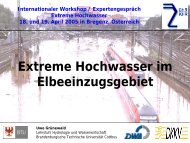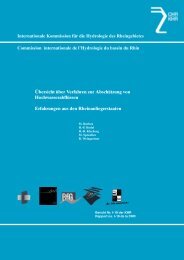ABSTRACTS 'Extreme Discharges' - CHR-KHR
ABSTRACTS 'Extreme Discharges' - CHR-KHR
ABSTRACTS 'Extreme Discharges' - CHR-KHR
You also want an ePaper? Increase the reach of your titles
YUMPU automatically turns print PDFs into web optimized ePapers that Google loves.
The following paragraph presents the results achieved at the macro scale, which are based on a regionalisation<br />
for the lower and upper meso-scale. However, the small scale results are not presented her, but are given in the<br />
corresponding final report published by the <strong>CHR</strong>.<br />
The LAHOR-study is an example of a multi-scale, process oriented coupling of different models in order to<br />
assess the impacts of land-use and river training measures on the runoff of a large catchment. For the first time it<br />
was possible to give quantitative estimates for the impacts of land-use change and river training measures on the<br />
flood conditions for the river Rhine.<br />
Three different land-use scenarios in the catchment, focussing on urbanisation and/or urban storm water treatment,<br />
have been taken into consideration:<br />
1. Scenario D1 is based on a rather realistic scenario of a further ca. 10% expansion of urban areas;<br />
2. Scenario D2 includes the increase of urban area of scenario D1 and, additionally, a planned project for<br />
controlled infiltration of urban storm runoff in 2500 km² urban areas, as recommended in the flood action<br />
plan of the International Rhine Commission in 1998, and<br />
3. Scenario D3 representing an "extreme scenario" of a 50% increase of urban areas.<br />
All scenarios D1, D2, and D3 also consider the effects of the planned or already constructed flood defence<br />
works along the Rhine between Maxau and Lobith. These modelled river training measures include flood polders<br />
along the Upper Rhine below Maxau (total volume 79.2 10 6 m³) and along the Lower Rhine (total volume<br />
65.4 10 6 m³). However, the planned flood polders along the Upper Rhine upstream of Maxau (207.6 10 6 m³)<br />
have not been assessed in this study.<br />
These three scenarios of land use and/or river training (river retention) measures were simulated driven by three<br />
different scenarios of meteorological forcing, one observed extreme and large-scale precipitation situation and<br />
two designed "extreme meteorological scenarios" in order to test the model system for even more severe meteorological<br />
conditions.<br />
1. Scenario M95: Meteorological forcing (in its observed spatial and temporal distribution) of Jan/Feb 1995<br />
which caused a flood in the Rhine with a return period > 100 years,<br />
2. Scenario M95+: Meteorological forcing of Jan/Feb 95 plus an increase of precipitation of 20%,<br />
3. Scenario M95++: Meteorological forcing of Jan/Feb 1995 plus a linear increase of precipitation of 20% plus<br />
an additional pre-event snow water equivalent of 20mm over the whole catchment<br />
66





